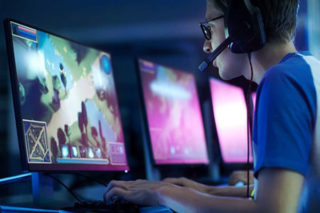Recent Articles
Boost higher ed recruiting with athletic facility design – Esports
by Erin P. Froschheiser, RA, NCARB, LEED AP
This is the fifth and final installment of a blog series started in March 2019 by LEO A DALY Project Manager Erin Froschheiser. Throughout the series, she has shared firsthand data and feedback from LEO A DALY fieldhouse and wellness-facility clients. She discusses feedback from clients, stakeholders, students and school staff, who reflect on a facility’s ultimate influence on recruiting, retention and perception.
Part 5: The Evolution of Esports
Electronic sports are organized, multiplayer video-game competitions. Until now, this series has explored facilities that leverage technology and flexibility, in one form or another. While none of these facilities installed technology specifically for Esports, the inclusion of audio-visual, electrical and data infrastructure takes on greater importance at schools that offer Esports programs, and that trend is not likely to change any time soon.
 Michael Brooks, executive director at the National Association of Collegiate Esports (NACE), estimates that 40 percent of Esports programs are managed under the umbrella of school athletics.
Michael Brooks, executive director at the National Association of Collegiate Esports (NACE), estimates that 40 percent of Esports programs are managed under the umbrella of school athletics.
“But most campuses are using whatever space they can find,” he said.
Purely competitive Esports programs require, at a minimum, a robust technology framework.
“If you had asked me a year ago what these programs need,” Michael said in January 2019, “I would have told you not much beyond a computer lab, and like most computer labs, you need to account for bandwidth issues.”
But that was at a time when the fledgling phenomenon of Esports tended exclusively toward competition, and most players participated without a live audience.
“What we’re seeing now is more demand for sound booths and streaming screens,” Michael said.
Screens allow fans to spectate using interactive livestreaming web apps, such as Twitch or Mixer.
Also in 2018, more students of all ages participated in Esports at a club level than ever before.
“I think you’re going to see larger facilities opening up to general students with a need for many more computers,” Michael said.
Some facilities, for example those at Boise State, Full Sail University and the University of California at Irvine, generate revenue by charging users for competitive or non-competitive use of Esports computers and infrastructure. According to Michael, these universities charge a lower price for general use and a premium price to compete.
Forward-thinking schools that plan thoughtfully and incorporate technology infrastructure from the start may enhance the attractiveness of their Esports programs and their facilities in general, as well as building in a source of revenue.
Read previous installments:
Part 1 (and Introduction): UNMC Expands Services to Attract Students and Faculty
Part 2: Athletic Programs Attract Non-Athletes, Too
Part 3: Integrating Wellness Functions and Technology
Part 4: Showcasing Values Through Design to Attract Talent and Financial Support
 About the Author
About the Author
Erin P. Froschheiser With more than 16 years of experience, Erin Froschheiser stands out to clients for her service-oriented style of leadership and successful track record of delivering complex projects. She believes wholeheartedly that today’s facilities should meet the needs of their users, while maintaining adaptability. Erin can be contacted at 402.390.4457 or EPFrosch@leoadaly.com.
